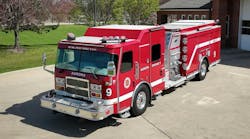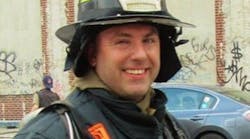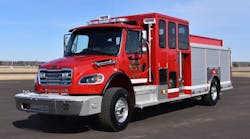The following are recommendations that may prevent future tragedies along the nation's highways and interstates, reviewing the tragedy that was discussed in the May column.
1. Fire departments should establish and implement standard operating procedures (SOPs) regarding emergency operations for highway incidents.
Discussion: Firefighters operating at the scene of a motor vehicle incident on a highway are in danger of being struck by oncoming motor vehicles. SOPs have recently been developed and implemented by this fire department (through an interdepartmental agreement) which require a police department vehicle to be dispatched for traffic control along with fire department personnel to scenes of motor vehicle incidents.
2. Fire departments should ensure that fire apparatus are positioned to take advantage of topography and weather conditions (uphill and upwind) and to protect firefighters from traffic.
Discussion: The driver of Ladder 2 had positioned the apparatus along the median wall approximately 150 yards behind Squad 2. This provided a safety zone for the personnel of Squad 2 and the occupants of the vehicle involved in the initial incident along the median wall.
After Ladder 2 had been rear-ended by car 2, the need for a safety zone was then extended to include Ladder 2. When the firefighters exited the vehicle, they had no protection from oncoming vehicles. The space between Ladder 2 and the concrete median provided a safety zone. However, the firefighters were moving themselves and the injured driver to that safety zone when they were struck by car 3.
Firefighters should exit the apparatus and work as far away from traffic as feasible. Firefighters should avoid working where the apparatus could be struck and pushed by another vehicle.
3. Fire departments should ensure that firefighters responding to a highway incident or fire must first control the oncoming vehicles before safely turning their attention to the emergency in the event police have not arrived.
Discussion: When a fire company arrives on the scene of a highway emergency and there are no police to control traffic, firefighters must first control the oncoming vehicles before safely turning their attention to the emergency. Ladder 2 provided protection from oncoming traffic for Squad 2 by placing their apparatus directly behind Squad 2. Ladder 2 acted as a shield, but left firefighters exposed to traffic.
The interstate highway on which the incident occurred has numerous overpasses, making it difficult for emergency personnel to provide adequate warning to motorists of upcoming emergency scenes. The use of warning signals such as flares (taking into account flammable/combustible hazards), signs, cones or flags is recommended, in addition to the operation of emergency operating lights on the apparatus. It is recommended that warning signal devices be placed a minimum of 350 feet behind the apparatus (a farther distance may be required taking into account line-of-sight, visibility, road and weather conditions) and positioned so they are visible to oncoming traffic for at least 350 feet beyond that. This placement allows a driver a minimum of 700 feet in which to stop a vehicle.
4. Fire departments should ensure that personnel position themselves and any victim or victims in a secure area when it is impossible to protect the incident scene that poses an immediate danger.
Discussion: The firefighters from Ladder 2 were exposed to the immediate danger of oncoming traffic when they exited the apparatus after it had been rear-ended. The captain of Ladder 2 was attempting to control oncoming traffic by flagging them over into the other two lanes when car 3 lost control. The firefighters attending to the injured driver were in the process of moving themselves and the driver to a safe area between Ladder 2 and the median wall when the car struck them. The uninjured firefighter from Ladder 2 had moved the injured firefighter from Ladder 2 out of the path of oncoming traffic before administering aid.
Victims should be moved as soon as feasible to a secure area to protect both the victims and the personnel attending to those victims from oncoming traffic.
5. Other agencies, such as the Department of Transportation (DOT) or highway department, can help. They should consider the use of a "changeable message sign" to inform motorists of hazardous road conditions or vehicular accidents.
Discussion: The need for this sign arises from the fact that this particular section of the highway (approximately six to eight miles) has been known to be hazardous during and after wet weather conditions. The sign would be installed permanently, spanning over the interstate, and the message would be controlled from the Emergency Operations Center (EOC). Two signs would need to be installed, one for each direction of the interstate.
The message would be updated remotely on a real-time basis by the EOC when incidents are reported on the interstate beyond the signs' locations. This would inform motorists of hazardous conditions or vehicular incidents ahead.
The Oklahoma DOT reported that for the period from Jan. 1, 1996 to July 31, 1999, a total of 160 motor vehicle accidents occurred on this particular stretch of interstate. The need to identify areas that have higher rates of automobile incidents should be evaluated so that SOPs for emergency personnel can be tailored to the needs of particular sites (e.g., blind curves or corners, hills or sloped areas, and high-traffic areas). Fire departments can work with local highway departments to identify trouble areas and devise solutions to those problem areas.
I would like to thank NIOSH for providing some of the information included in this column.
Michael Wilbur, a Firehouse® contributing editor, is a lieutenant in the New York City Fire Department, assigned to Ladder Company 27 in the Bronx, and has served for the past five years on the FDNY Apparatus Purchasing Committee. He has consulted on a variety of apparatus-related issues throughout the country.




